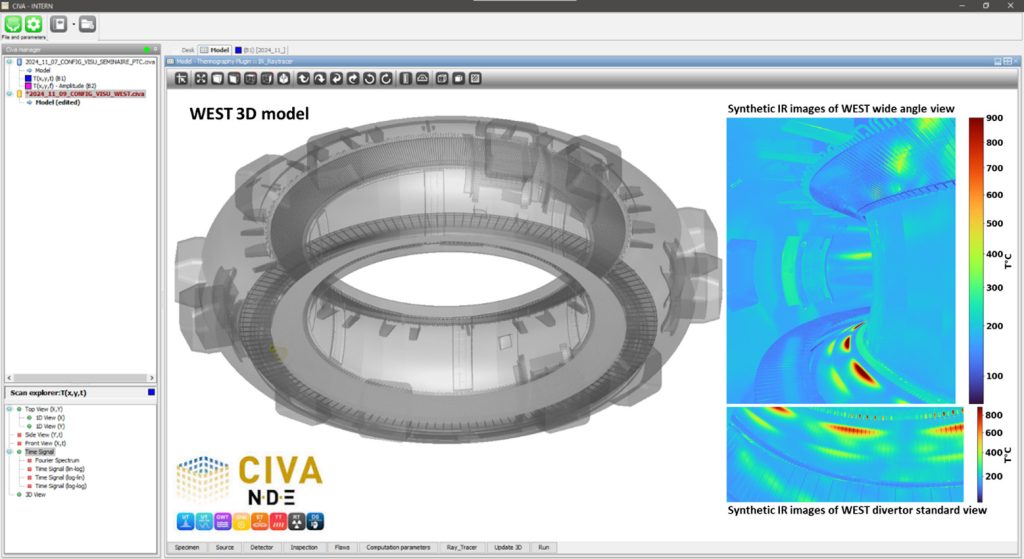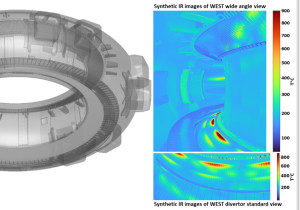As part of the MIRO Transverse Competence Project in Numerical Simulation, due to start in 2023, a simulation tool for Infrared (IR) imaging diagnostics, developed by CEA-IRFM to monitor the walls of WEST and soon ITER, has been integrated into CEA-LIST’s CIVA multi-physics platform, a world leader in the analysis of Non-Destructive Testing (NDT) methods. This collaboration has not only enhanced CIVA’s IR simulation and analysis capabilities, but also improved IR image generation with optimized calculation times for real-time applications. It also guarantees the dissemination of this research work through its integration into a widely-used professional code.
CIVA software is a simulation and analysis tool dedicated to non-destructive testing (NDT). Developed by CEA-List and distributed by Extende, CIVA is used by many manufacturers to simulate various inspection techniques (ultrasound, eddy current, thermography, radiography, tomography) and to analyze data from experimental or simulated measurements [1].
IR thermography is an NDT method with many advantages: it enables the surface temperature of critical components to be monitored non-invasively, over large fields of view and with a high acquisition frequency. However, the interpretation of thermal images is complex, due to the many “parasitic”
disturbances (uncertainties in target emissivity, presence of reflected flux, influence of the instrument), which can lead to significant errors in temperature measurements. This complexity still limits the systematic use of this technology without expert advice. Simulation is becoming a key element in understanding the physical processes involved in the measurement chain, and in quantifying precisely the disturbing phenomena.
IInitially designed to monitor the walls of magnetic confinement fusion machines, a new infrared radiative calculation kernel developed by CEA-IRFM has been added to CIVA’s infrared thermography module. This kernel enhances CIVA’s capabilities by integrating infrared image simulations, particularly useful for improving the interpretation of measurements in difficult environments such as those found in fusion machines. The simulation tool was initially developed and tested to address the issue of wall temperature control, which brings together a number of major challenges for IR measurement: an all-metal (and therefore reflective) and hot environment with temperatures ranging from 100 to 3000°C, changes in the surface state of materials subjected to high heat and particle fluxes leading to erosion-deposition phenomena [2]. The simulation tool has proved particularly useful in discriminating between false hot spots, caused by parasitic reflections, and real hot spots, which represent a real risk to machine integrity.
L’outil de simulation d’images infrarouges intégré dans CIVA repose sur un algorithme de lancer de rayons par Monte Carlo, capable de simuler des scènes thermiques 3D complexes. Ces scènes sont caractérisées par des distributions fines de champs de température et par diverses propriétés de surface en termes d’émission et de réflectivité. Aujourd’hui, entièrement optimisé et compatible avec plusieurs plateformes (CPU/GPU), ce nouveau module réalisé dans le cadre du projet transverse MIRO permet de simuler des images infrarouges de 512×640 pixels en utilisant plus d’un milliard de rayons, le tout en moins de 5 secondes sur des cartes graphiques accélérées (GPU NVIDIA A40 RTX) contre 32 mn sur un processeur Intel à 48 cœurs. Cela représente une accélération d’un facteur de plus 450 entre GPU RTX et CPU. L’image 1 représente dans CIVA une vue 3D de l’enceinte du tokamak WEST et des images simulées d’une des caméras infrarouges surveillant la température des parois.
Going a step further, this (direct) model of realistic infrared simulation also serves as a starting point for the development of measurement inversion algorithms. Learned through simulation, these algorithms aim to determine object surface temperatures from IR measurements, while correcting for disturbing phenomena [3,4].

Figure 1: Visualization in CIVA of a 3D model of the WEST tokamak enclosure and simulated images from one of the infrared cameras monitoring wall temperature.
Motivated by the challenges posed by the protection of the internal components of the WEST tokamak and magnetic confinement fusion machines, the integration of this research work into the CIVA professional tool enhances its value by enabling its dissemination for various types of applications.
[1] Calmon P., et al., CIVA: An expertise platform for simulation and processing NDT data, Ultrasonics 44 (2006), Pages 975-979.
[2] Aumeunier M-H. et al., Surface temperature measurement from infrared synthetic diagnostic in preparation for ITER operations, Nuclear Fusion, Volume 64, Number 8 (2024)
[3] Juven A. et al., Temperature Estimation in Fusion Devices using Machine Learning techniques on Infrared Specular Synthetic Data, 2022 IEEE 14th Image, Video, and Multidimensional Signal Processing Workshop
[4] Miorelli R, et al., Defect sizing in guided wave imaging structural health monitoring using convolutional neural networks, NDT & E International 122 (2021) 102480


